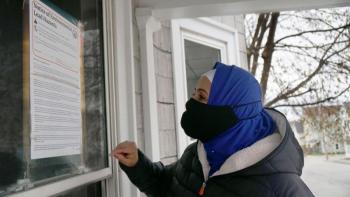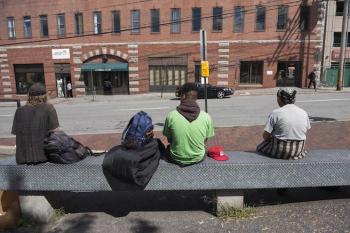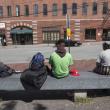Legislators address housing shortage, but advocates say so much more needs to be done
For seven years, off and on, Cheryl Harkins lived out of her car and in a homeless encampment in Portland. Harkins, who is 100% disabled related to degenerative conditions, said her legs would swell from sleeping in her Subaru.
One time she woke up with 15 ticks on her. Another time her face “swelled shut” from mosquito bites.
Harkins, who now serves on the statewide homeless council, said she still gets emotional when recalling that time in her life. People experiencing homelessness are called names, judged and excluded from family gatherings, she said.
“I firmly believe that homelessness creates mental health issues,” Harkins said.
Even after getting into housing, Harkins’ health continued to suffer. Her blood tested for high levels of carbon monoxide that she said was due to her apartment’s faulty furnace. Other places she lived had asbestos, flooding and leaking toilets.
Legislation moving ahead in Augusta this month aims to address some of the state’s stubborn affordable housing problem, but there’s still much more to be done.
The repercussions extend beyond housing. The conditions where people live and function affect their health outcomes and quality of life — what experts call a “social determinant of health.’’
The air you breathe, the water you drink and where you live all impacts your health. So does access to childcare, transportation and broadband, said Deborah Deatrick, a retired senior vice president for community health improvements at MaineHealth.
“(These factors) are more profound influences, frankly, on healthcare outcomes than things like the number of doctors we have or the number of hospitals,” said Deatrick, now a public health consultant.
Mainers with a history of homelessness over the last 13 months were up to 19 times more likely to spend time in a hospital when they were without housing than when they had a place to live.
In a state with some of the oldest houses in the country, the vast majority of Maine children with lead poisoning live in homes built before 1950. Lead poisoning has been linked to developmental delays, behavioral problems, poor school performance and lower earnings.
Long waiting lists for affordable housing add to the stress, which also affects health. Before the pandemic, 26,000 Maine households were on waiting lists for federal rental assistance — and that’s only gotten worse.
Experts estimate Maine lacks 19,000 affordable housing units and builds only about 250 annually.
Building more units is important but not the whole solution, Deatrick said. It’s also important to take into account where the housing is in relation to public transportation, schools, hospitals, childcare and good jobs.
“All these things are really part of health,” Deatrick said. “It took the pandemic to have us realize that all this stuff is interconnected.”
Rising rents
The fair market rent for a one-bedroom apartment in Maine is $875 a month, but the average renter in Maine earns enough to pay $671 a month on rent, according to a recent report from the National Low Income Housing Coalition. A Mainer earning minimum wage could afford only $632 a month.
Part of the problem is that material and maintenance costs have increased in recent years, contributing to rising rents, said Jeff Levine, interim director of the Maine Affordable Housing Coalition.
“Portland always had a bit of an affordability challenge,” Levine said. “What you’ve seen over the last 10 years is that challenge sort of becoming statewide. There’s very few places in Maine now where the median household income can pay for the median apartment.”
Paying more than 30% of income on rent is considered “rent burdened.” One in five Mainers spend more than half their income on rent.
This leaves little room for healthcare and emergencies, and contributes to stress, which can impact health outcomes, said Tom McLaughlin, a professor in the School of Social Work at the University of New England.
Debate about high rents seems cyclical, resurfacing over the decades as the economy ebbs and flows, McLaughlin said. But what feels different this time is that units in Portland appear to be getting displaced by more hotels.
In recent years, Maine created the state affordable housing tax credit and set aside COVID-19 relief funds for housing, Levine said.
“It’s going to be important for Maine to realize that this problem doesn’t fix itself,” Levine said. “If we care about the health of our residents and the economy of the state, which is directly related to the health of our residents, this is a problem we’re going to have to tackle and it’s not going to be a one-time solution.”
The ‘battle’ for housing
During this year’s legislative session, lawmakers considered a handful of bills aimed at Maine’s housing crisis. And the supplemental budget signed into law this week included $22 million for an Emergency Housing Relief Fund to address homelessness, including rental assistance.
The bill that captured the most attention, LD 2003, loosens zoning restrictions to allow up to two units on plots zoned for single family use and accessory dwelling units, such as mother-in-law apartments, in residential areas. Up to four units would be allowed in designated “growth areas.”
The measure passed both the House and Senate.
The original version of the bill, introduced by House Speaker Ryan Fecteau (D-Biddeford), contained many of the recommendations from an affordable housing commission formed last year.
But the final version was stripped down significantly. Opponents, including the Maine Municipal Association, expressed concern that measures hampered local control and forced a one-size-fits-all approach to the housing shortage across the state.
Housing advocates applauded the passage of LD 2003 as progress toward expanding available housing.
But even passing the stripped-down legislation was “such a battle,” said Deb Ibonwa, policy and legal advocate with Maine Equal Justice, a nonprofit civil Legal Aid and economic justice organization.
“It’s always been a fight getting people to care and prioritize, and understand that housing is healthcare, and housing is a human right,” she said.
It’s important to continue adjusting zoning restrictions to allow and encourage development of affordable housing, Ibonwa said. Zoning laws that only allow single-family dwellings in wealthier neighborhoods make it difficult for lower income families to afford to live there.
Mainers of color, who are historically more economically disadvantaged, end up renting in parts of the state that are higher density, where there’s already a housing crunch, Ibonwa said. They make up a disproportionate portion of renters and often face discrimination in the housing market.
Black Mainers make up 1.6% of the state population but 26% of Maine’s homeless population.
“They’re over-represented in that low-income population,” Ibonwa said. “(It) also ends up that they’re going to be disproportionately represented in the homeless population. And they’re going to face health disparities as well.”
Quality housing
The state affordable housing tax credit, enacted two years ago, is the “best thing (Maine lawmakers) have ever done on housing,” said Lado Lodoka, who represents the Maine Immigrant Housing Coalition, which is part of Justice Housing Maine.
The state tax credit is in addition to the federal Low Income Housing Tax Credit. Last year the two credits together provided about $30 million in subsidy for affordable housing developers, according to MaineHousing.
But it’s important to ensure that affordable housing is also quality housing, Lodoka said. New immigrants often come in at the bottom of the economic ladder and may have to accept cramped or crumbling living situations.
As of this month, Portland was finding shelter for nearly 1,600 asylum seekers and homeless people, according to the Portland Press Herald.
The pandemic underscored this problem, Lodoka said. Larger families who could only afford to rent one- or two-bedroom apartments had difficulty quarantining after exposure to the virus.
In addition, Maine’s old houses mean children who live in crumbling homes are more likely to be exposed to lead paint, which can damage their brains and development.
Communities like Lewiston and Auburn have received grants to address homes with lead paint, but mitigation is expensive and time-consuming. In 2020, MaineHousing abated 145 units through its program, but more than 313,000 units in the state could date before 1978.
“The quality (of the housing) is a bigger problem than we as a community would like to accept,” Lodoka said. “If we accept it as a problem, then we are obligated to find a solution to it.”
‘Ricocheting’ through systems
Mainers with a history of homelessness were, on average, 10 times more likely to end up hospitalized over the past year when they were unhoused compared to when they had housing. At one point in December, they were 19 times more likely to be in a hospital.
These findings come from a committee of 18 organizations that tracked the state’s group of “long-term stayers” — Mainers who were homeless for 180 days or more over the past year.
Last month, four of the 125 unhoused long stayers were in the hospital. None of the 349 in housing were hospitalized.
Living outside makes it difficult to perform normal bodily functions and can exacerbate existing mental health challenges, said Cullen Ryan, executive director of Community Housing of Maine, which provides supportive housing and advocacy.
Symptoms of serious and persistent mental illness are exacerbated by stress, Ryan said. “And arguably the most stressful situation you can be in is chronic homelessness.”
When people are housed, the symptoms decrease dramatically, Ryan said.
And once people are housed, they tend to stay housed, Ryan said. Over the past seven years, 388 long stayers found housing, with 92% staying in housing.
“This small population of people … are ricocheting through our most expensive emergency systems all the time and costing us a great deal of money,” Ryan said. “And when they’re housed they stop ricocheting.”
There’s a backlog of adequate housing supply dating back decades, which creates “mushrooming” problems as housing stock crumbles, Ryan said. Maine needs to simultaneously increase its overall housing stock, affordable housing and supportive housing, and build them all to last.
“When we move people to nice places, they tend to keep them up and take good care of them,” Ryan said. “They tend to be proud to live there and they tend to really want to make it work. And they tend to feel better about themselves.”



























